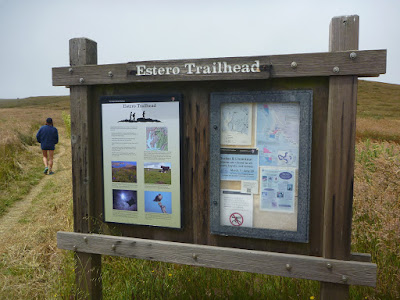 |
| Jepson Prairie Nature Trail near Olcott Lake with Mount Diablo far back |
The
Jepson Prairie Preserve is a
National Natural Landmark at the western edge of the Central Valley in Northern California, preserving
vernal-pool habitats,
mima mounds,
native perennial grassland and some
threatened grass, insect and aquatic species [1-4]. Also called
Jepson Prairie Reserve, the
(P)reserve is found northwest of the Sacramento-San Joaquin River Delta. From the preserve, you will not be able to overview this inland delta, but you can see across it, for example, to spot Mount Diablo in the south—often amidst a layer of haze.
The preserve is almost treeless, as expected for prairieland. A few non-native eucalyptus trees are growing within its picnic and lecture square. Further, “tall, non-native towers” that suspend sizzling overhead power lines are part of the prairie terrain, which today is surrounded by agricultural land. A
Self-Guided Nature Trail with numbered posts allows visitors to explore the grassland and the northern shore of
Olcott Lake [3].
Olcott Lake and other, nearby
vernal pools exist as
alkaline water bodies during and shortly after the rainy winter season. Olcott Lake is larger than a typical vernal pool and is sometimes called a
playa pool. When filled with water, the vernal pools teem with microscopic organisms, shrimp, salamanders, wading birds and migratory waterfowl. The bottom of Lake Olcott consists of water-impenetrable clay-like soil, such that rain runoff gets seasonally collected in the shallow pool—without seeping into the ground and maintaining a long-term water reservoir.
A lecture canvas fixed to the fence near the
The Nature Conservancy plaque says that on rare occasion a coyote, racoon or beaver may be observed here. The canvas includes illustrations by Ann Ranlett showing the
Fairy Shrimp. This shrimp species is legally protected under the federal Endangered Species Act, as are the
Vernal Pool Tadpole Shrimp and the
California Tiger Salamander.
 |
| Shoreline of dried-out Olcott Lake with plant distribution pattern |
When I visited the area in early summer of this year, the water of Olcott Lake had evaporated completely. Since its shoreline is successively moving down into the lakebed while the water is receding, a banded shoreline pattern evolves each spring with plants distributed in dependence of the changing water level and the accumulation (precipitation) of dissolved salts. I am hoping to learn more about the interesting ecology of vernal pool plants on one of the guided tours next spring.
The preserve is named for botanist
Willis Linn Jepson, who first described the vernal pool flora in 1892—80 years before enough momentum was gained to protect Olcott Lake, the surrounding prairie and its diverse plant- and wildlife [4].
Getting to the Jepson Prairie Preserve
The Jepson Prairie Preserve is located south of
Dixon and east of
Fairfield in
Solano County, California.
From I-80, on your way
southwestbound from Sacramento, take the
Dixon/Highway 113 exit and go
south on Hwy 113 for about twelve miles. Where Hwy 133 turns east, continue south. Carefully cross the railroad tracks and find parking space next to the fenced eucalyptus square on your left.
From I-80, on your way
northeastbound from the Bay Area, take the
Suisun City/ Highway 12 exit and go
east on Hwy 12. About eight miles east of Suisun City, turn left on Lambie Road. At its junction with Goose Road, turn left. At the Goose/Creed Road junction turn right and go east to the T-junction, at which Creed Rd. meets Hwy 113. Go north and then west on Hwy. 113, until you get to the point where Hwy. 113 turns north toward Dixon. Here, you want to turn left, go south, cross the railroad tracks and park at the eucalyptus square.
The Nature Trail gate is across the gravel road, west of the eucalyptus trees.
 |
| Gate of Nature Trail in Jepson Prairie Preserve |
References and more to explore
[1] Katherine F. Mawdsley:
Jepson Prairie Preserve Today.
Fremontia January
2000,
27 (4), 52-55 [
www.cnps.org/cnps/publications/fremontia/january_2000/8mawdsley.pdf].
[2]
UC Davis Natural Reserve System - Jepson Prairie Reserve [
nrs.ucdavis.edu/jepson.html].
[3]
Jepson Prairie Self-Guided Nature Trail:
nrs.ucdavis.edu/Jepson/Jepson%20Prairie%20Self-Guided%20Trail.pdf.
[4] Solano Land Trust:
Jepson Prairie Preserve [
www.solanolandtrust.org/JepsonPrairie.aspx]

















































